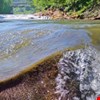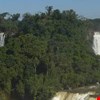
The Matura watershed is located in the eastern region of Trinidad. The major threats to watershed degradation originate from anthropogenic activities that are unsustainably executed. Several mitigation measures were initiated by the regulatory agencies that constantly monitor the watershed as well as the community-based organisation, Nature Seekers.

The Pantanoso watershed in Montevideo has been identified as vulnerable to threats of intense rains and floods, posing risks to the human settlements. To combat the risks, action was taken by the local population and governmental authorities to engage in a project on Climate Related Disaster Risk Management. The key lesson is that strengthening vulnerable communities upon climate risks represents a key tool for the IWRM, since it contributes to empowering the population.

Scientific and estuarine research on the Chesapeake Bay pinpointed several areas that required attention including nutrient over-enrichment, dwindling underwater Bay grasses, and toxic pollution. Action was taken and the Chesapeake Bay Commission was established to address the issues. This case illustrates how the use of modelling can be a cost-effective tool in helping to implement watershed restoration actions and monitor goals set by stakeholders.

In Carabobo State, the urban and agricultural expansions are the main causes of watershed problems resulting from degradation of forests, deforestation and inadequate solid waste management. Since 2009, action has been taken to combat these developments through participatory public policies which focus on environmental education and sustainable development. The key to the success of the project has been extensive capacity building in combination with concrete management tools.

To supply water to a growing population, an aqueduct was built in the watershed of El Limón River in Tovar municipality. However, this aqueduct does not provide sufficient supply, creating conflicts among the communities. To solve these, agreements on the use and conservation of water resources have been made among the communities, involving both rural villages and urban areas. This illustrates the benefits of a participatory approach.

For many businesses, issues of water scarcity are becoming increasingly relevant to their activities, manifested as increased costs or difficulties to obtain water as users compete for rights. To understand water dependencies in time and space, many companies apply the measure of water footprint, estimating water use throughout the value chain. Using this measure can give important insights into variation between countries in terms of how much of the water relates to production.